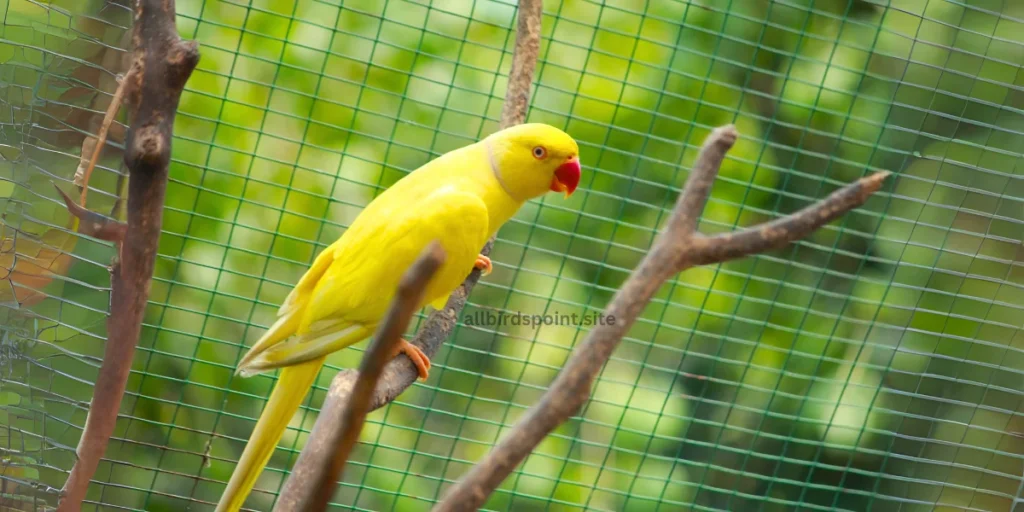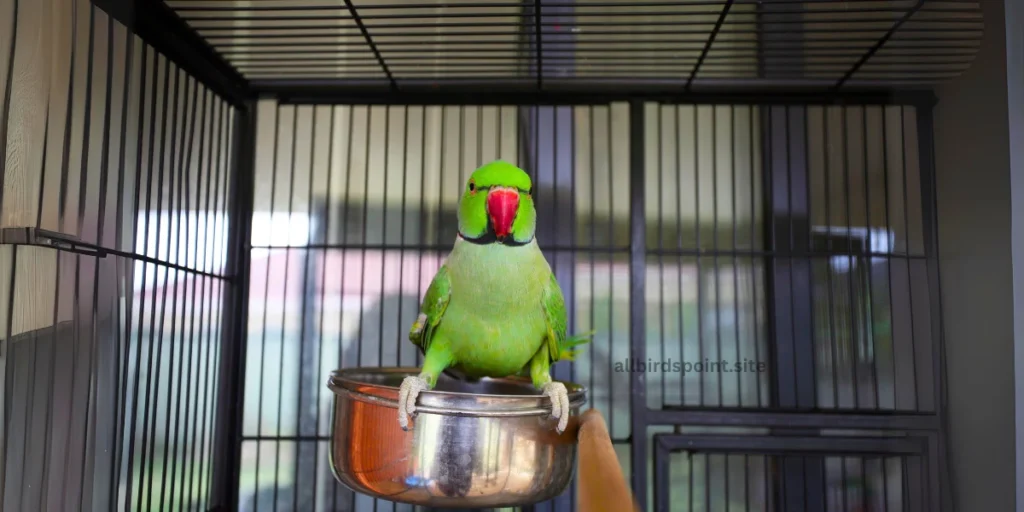Indian Ringneck Parrots are colorful, smart, and charming birds that make wonderful pets for people who love birds. They are known for their bright feathers, playful personalities, and ability to learn words and sounds. If you’re interested in owning an Indian Ringneck Parrot, this guide covers everything you need to know, from their background and diet to training and health care.
Background and History of Indian Ringneck Parrots
Indian Ringneck Parrots, also called Rose-ringed Parakeets, come from Asia, especially India, Pakistan, and Sri Lanka. For centuries, people have admired these parrots for their beauty and intelligence. In ancient times, Indian royalty kept them as pets, and they were considered symbols of good luck. In the wild, you can find these parrots in forests, farms, and even some cities. Today, they’re popular worldwide as pet birds.

What Do Indian Ringneck Parrots Look Like?
Indian Ringneck Parrots are medium-sized, colorful parrots with distinct features:
- Color: The natural color is a bright green, but thanks to selective breeding, you can now find them in blue, yellow (called lutino), albino (all white), and violet.
- Size: They are about 14-17 inches long from head to tail, making them medium-sized birds.
- Lifespan: With good care, Indian Ringnecks can live up to 25-30 years in captivity, so they’re a long-term commitment.
| Feature | Details |
|---|---|
| Origin | India, Pakistan, Sri Lanka |
| Colors Available | Green, Blue, Yellow, Albino, Violet |
| Size | 14-17 inches (35-43 cm) |
| Average Lifespan | 25-30 years with proper care |
Personality and Behavior of Indian Ringneck Parrots
Indian Ringneck Parrots are known for their unique and engaging personalities:
- Smart and Playful: They are very intelligent and curious. They love to play with toys and explore their surroundings.
- Independent: While they enjoy attention, they are also independent and may not always want to be handled. Each bird has its own personality; some love being social, while others prefer to observe from a distance.
- “Bluffing” Phase: Young Ringnecks often go through a phase called “bluffing,” where they may act aggressively or become a bit difficult to handle. This phase is normal and usually passes with gentle handling and patience.
Can Indian Ringneck Parrots Talk?
Yes! Indian Ringnecks are fantastic mimics. They can learn a wide variety of words, sounds, and even short phrases. With practice, many Ringnecks can speak clearly and mimic the voices of people around them. Regular interaction and encouragement can help them develop a good vocabulary, making them fun and entertaining companions.
What to Feed an Indian Ringneck Parrot
A healthy diet is essential for keeping your Ringneck happy and healthy:
- Pellets: High-quality parrot pellets should make up the bulk of their diet because they contain all the vitamins and minerals they need.
- Fresh Fruits and Vegetables: Indian Ringnecks love fresh produce. You can offer them fruits like apples (without seeds), bananas, and berries, and vegetables like carrots, spinach, and bell peppers.
- Seeds: Seeds can be given as a treat, but in moderation since they are high in fat. Sunflower seeds and millet are favorites but should only be given occasionally.
- Avoid: Foods like chocolate, avocado, caffeine, and alcohol are toxic to parrots and should never be given.

Setting Up the Perfect Home for Your Indian Ringneck
Your parrot’s cage and surroundings are very important for its well-being:
- Cage Size: Indian Ringnecks need a spacious cage to move around. The cage should be at least 24 x 24 x 36 inches.
- Perches: Provide different types of perches to help keep their feet strong and healthy. Natural wood perches are great for them to grip.
- Toys: Ringnecks are very curious and need mental stimulation, so fill their cage with toys. Toys for chewing, climbing, and foraging will keep them happy and engaged.
- Out-of-Cage Time: These parrots need at least 2-4 hours outside their cage every day. Letting them explore a safe, bird-proofed room helps them stay active and curious.
Training and Socializing Your Indian Ringneck Parrot
Training your Ringneck Parrot can be a fun bonding experience:
- Use Positive Reinforcement: Reward your parrot with treats, gentle words, and praise when they do something right. This makes them want to learn and repeat good behaviors.
- Set a Routine: Parrots are creatures of habit. Having a daily routine for feeding, playtime, and training helps them feel secure.
- Handling and Socializing: Gently handling your Ringneck and exposing them to different people, sounds, and experiences will make them friendlier and less likely to act shy or fearful.
Common Health Issues in Indian Ringneck Parrots
With good care, Indian Ringnecks are usually healthy birds, but they can still face some health issues:
- Psittacosis: This is a bacterial infection that can spread to humans. Signs include breathing problems, sneezing, and fatigue. Regular vet check-ups can help catch any issues early.
- Feather Plucking: This usually happens if a parrot is bored or stressed. Providing toys, attention, and proper nutrition can prevent it.
- Respiratory Problems: Ringnecks can have respiratory issues, especially if they’re exposed to smoke, strong perfumes, or drafts. Keep their living area clean and smoke-free.
- Regular Vet Visits: Take your parrot to a vet specializing in birds once a year for a check-up. This will help ensure they stay healthy and catch any problems early.
Breeding Indian Ringneck Parrots
Breeding Indian Ringnecks is a commitment, and it requires the right setup and knowledge:
- Nesting Box: During breeding season, which is usually in the spring, they need a secure nesting box.
- Egg Laying and Incubation: A female Ringneck typically lays 2–6 eggs, which hatch in about 23 days.
- Care for Chicks: Let the parents take care of the chicks at first, as they will know how to care for them best. However, some breeders choose to hand-feed the chicks to make them tamer.
Pros and Cons of Owning an Indian Ringneck Parrot
Indian Ringnecks are great birds, but they may not be for everyone. Here’s a quick look at the advantages and challenges of having one as a pet.
Pros
- Very Intelligent: They can learn tricks, sounds, and words.
- Long Lifespan: They can live up to 30 years or more with good care.
- Beautiful Appearance: Their colors and unique look make them a joy to observe.
Cons
- Need for Interaction: They can get bored and lonely if left alone for too long.
- Can Be Noisy: Ringnecks can be loud, especially when they want attention.
- Requires Patience: They may go through a “bluffing” phase and can be stubborn at times.

Are Indian Ringneck Parrots the Right Pet for You?
Indian Ringnecks are wonderful companions for people who have the time and patience to care for them. They are intelligent and curious, so they thrive in environments that keep them active and mentally stimulated. If you’re prepared to spend a few hours every day interacting with your parrot, and you have the commitment to care for them for many years, an Indian Ringneck Parrot could be the perfect pet for you.
Conclusion
Indian Ringneck Parrots are amazing birds that bring color, intelligence, and joy into a home. They’re ideal for bird lovers who appreciate their unique personalities and need for stimulation. With the right care, attention, and environment, they can become loyal and entertaining companions for years to come. If you’re thinking about adding an Indian Ringneck Parrot to your family, remember that these birds require dedication but reward their owners with love and lots of entertainment.
FAQs
1. How long do Indian Ringneck Parrots live?
Indian Ringneck Parrots can live up to 25-30 years with proper care.
2. Can Indian Ringneck Parrots talk?
Yes, they are excellent mimics and can learn words, phrases, and even sounds from their environment.
3. Are Indian Ringneck Parrots good pets for beginners?
They can be good pets for beginners if you have the time, patience, and dedication. They need consistent handling, training, and daily interaction.
4. What should I feed my Indian Ringneck Parrot?
A balanced diet includes high-quality pellets, fresh fruits, and vegetables. Seeds can be given as treats but should not be the main diet.
5. Do Indian Ringneck Parrots need a large cage?
Yes, they need a spacious cage, ideally at least 24 x 24 x 36 inches, with room for toys, perches, and movement.
6. Are Indian Ringneck Parrots noisy?
They can be noisy, especially when bored or seeking attention. Regular interaction and mental stimulation can help reduce this.
7. How can I keep my Indian Ringneck Parrot healthy?
Provide a balanced diet, plenty of out-of-cage time, clean living conditions, and take them to an avian vet annually for check-ups.

1 thought on “Indian Ringneck Parrots: Care, Diet, Lifespan & Training Guide”